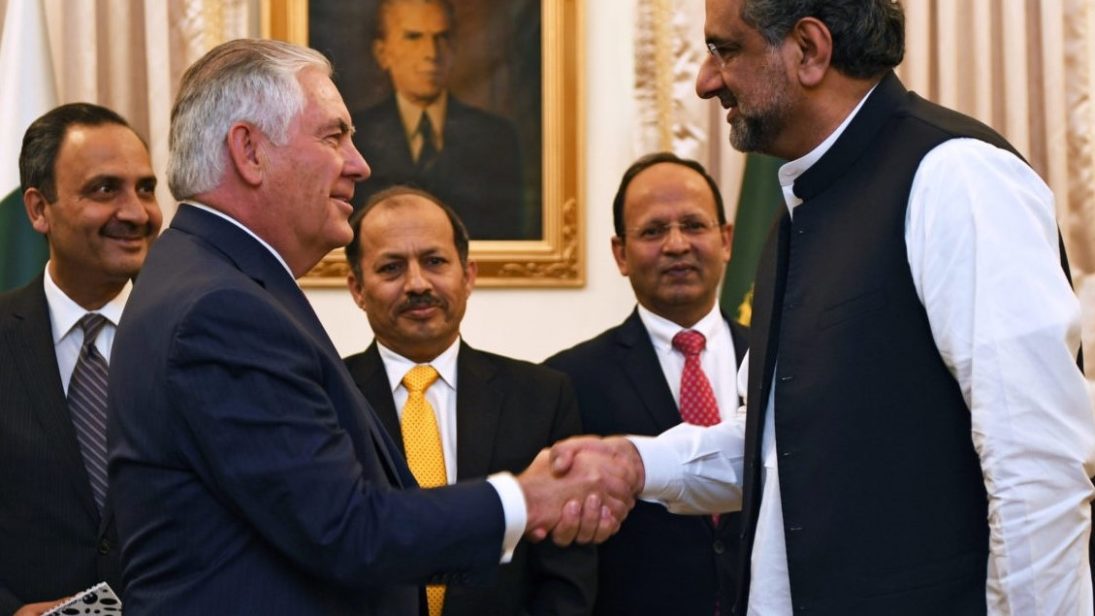
Recently unveiled by Secretary of Defense James Mattis, the 2018 National Defense Strategy (NDS) of the United States builds upon President Donald Trump’s December 2017 National Security Strategy (NSS) and also sets guidelines for future defense spending. Although many aspects of Trump’s NSS are being likened to President Barack Obama’s in 2010 and 2015, the NSS 2017 is a departure from its predecessors on India and Pakistan. In light of this, it is important to assess the effect of these documents on the future of U.S. relations with South Asia, particularly Pakistan.
Not only does the NSS 2017 acknowledge India’s emergence as a global power, but it also envisages a greater Indian role in the Indian Ocean and the broader region, in cooperation with Japan and Australia. This quadrilateral collaboration, when viewed in the context of the NDS’s objective of favorable regional balances of power in the Indo-Pacific region, highlights India’s position as a counterweight to Chinese influence. However, this objective can have significant repercussions for Pakistan. With India vying for greater influence in the Indian Ocean Region (IOR) and receiving support from the United States, the strategic stability of the region will be influenced negatively, potentially resulting in an arms race that Pakistan can hardly afford. From a Pakistani perspective, the IOR has become more problematic following the induction of India’s ballistic missile submarine INS Arihant in 2016, which resulted in Pakistan responding by completing its nuclear triad with the launch of the Babur missile in early 2017. Moreover, the growing U.S.-India partnership in the IOR and India’s access to U.S. weapons technology to help narrow its “gap with China” have led to a trilateral security competition among India, Pakistan, and China. Thus, an augmented Indian role with U.S. support may fuel this security competition by inviting reactions from China and Pakistan and destabilizing the region further.

With regards to Pakistan-U.S. relations too, the NSS 2017 has exacerbated existing tensions. For instance, the NSS 2017 asserts that the United States “continues to face threats from transnational terrorists and militants operating from within Pakistan.” However, Pakistan maintains that it is doing all it can to end the problem of terrorism and has asked Afghanistan as well to take “simultaneous efforts” to restore peace on its territory. Pakistan also views the United States policies as having aggravated the terrorism issue in the region. For instance, Pakistanis have long argued that the U.S. drone campaign is counterproductive and has radicalized an entire generation. In fact, the references to Pakistan in the NSS 2017 are being interpreted in Islamabad as a prelude to the Trump administration considering extending U.S. drone strikes in the country. The recent drone attack in the Kurram Agency confirmed these fears, prompting Pakistan to announce that such attacks could break the Pakistan-U.S. relationship.
The NSS 2017 also states that the United States worries about an “Indo-Pakistani military conflict that could lead to a nuclear exchange” and claims Washington will “press” Islamabad to continue demonstrating that it is a responsible steward of its nuclear assets. However, not only does the NSS 2017 fail to mention India’s nuclear assets, it actually emphasizes growing U.S. support for Indian endeavors to expand their defense and security related programs. India is already enjoying the fruits of the U.S.-India nuclear deal that paved the way for its subsequent membership into various nonproliferation and export control regimes, including the Australia Group and the Missile Technology Control Regime. This support for New Delhi without mitigating Islamabad’s concerns may serve to further strain already tenuous Pakistan-U.S. relations.
Considered together, the NSS 2017 and the NDS provide a clear indication of things to come. Firstly, these documents further strengthen India’s position vis-a-vis Pakistan and help India pursue its agenda in Afghanistan. The effect of these developments for the already deteriorating Pakistan-U.S. relations would be detrimental as it would reinforce the belief in Pakistan that the United States is pursuing policies that are harmful for the country. Secondly, they signal that there are no longer any supporters of the Pakistan-U.S. relationship under the current administration, whether in the White House, the State Department, or the Defense Department.
However, the Pakistani government’s response to hostility from the United States remains unclear. While some circles in Pakistan claim that the United States is no longer an ally, others insist otherwise. The government’s policy towards the United States remains ambivalent thus far, with contradictory statements that further confuse the issue. Notwithstanding claims that the relationship can be salvaged, there is little hope for Pakistan-U.S. relations, at least in the short term. The NSS 2017 spells out clearly that no matter what Pakistan does, the Trump administration’s Pakistan policy during the current term will not change. In the longer term, alleviating the United States’s concerns would require a rethinking of Pakistan’s Afghanistan policy, which directly impacts its domestic stability. The United States also needs to realize that stability in Afghanistan would be possible only if it continues to work with Pakistan as well as admit its own mistakes. Political stability in Afghanistan may require greater Pakistani efforts but it also requires that both Afghanistan and the United States do more.
Editor’s note: With the recent release of the National Security Strategy by the White House and the National Defense Strategy by the Pentagon, the Trump administration articulated its strategic priorities at home and abroad. In this four-part series, SAV contributors Monish Tourangbam, Hamzah Rifaat, Amina Afzal, and Pooja Bhatt analyze how these policy formulations may impact South Asia. Read the entire series here.
***
Image 1: U.S. Department of State via Wikimedia (cropped)
Image 2: SS Mirza/AFP via Getty Images


